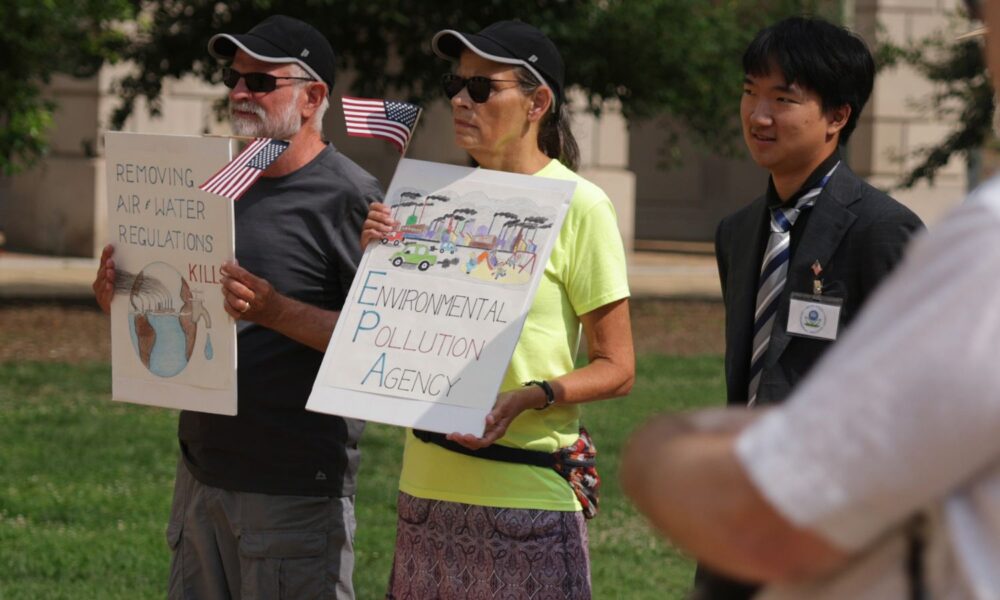On July 29, the Environmental Protection Agency (EPA) proposed rescinding the 2009 Endangerment Finding, a cornerstone of US climate policy that has strengthened federal climate action over the past 15 years. This foundational scientific determination establishes that heat-trapping emissions driving climate change pose harms to human health and well-being. Together with the 2007 Supreme Court ruling that heat-trapping emissions are subject to the Clean Air Act, this finding firmly establishes the EPA’s obligation and responsibility to regulate heat-trapping emissions. If this destructive proposal is finalized, it would effectively sideline the EPA from the fight to confront climate change.
To substantiate their claims, the EPA used a Department of Energy (DOE)-commissioned “report” that “critically reviewed” scientific literature on climate change, heat-trapping emissions, and its impacts in the US. But make no mistake: this is not a peer-reviewed scientific assessment. It is a 150-page disinformation document that misrepresents the scientific consensus on climate change and echoes fossil-fuel industry messaging. Still more alarming is that this document comes with a US federal agency seal of approval.
There are many trends that I enjoyed in the early 2000s, but recycling outdated climate denial tactics is not one of them. You can find some fact checks on the “report” that scientists have already contributed to here, here, and here. But we know why the fossil fuel industry is bringing this disinformation fad back: to cater to their interests and protect their bottom-line at the expense of our lives, our livelihoods, and our planet.
Rather than duplicate efforts underway for a point-by-point rebuttal of the “report”, I’d like to highlight the strategy the administration is employing, with some examples.
Disinformation Tactic #1
Cherry-pick data to downplay climate change and distort the science
The DOE “report” is riddled with cherry-picking. This classic disinformation tactic either selectively (A) picks a subset of text in cited literature, (B) a subset of cited works, or (C) a singular or a subset of datasets, in order to support a specific biased narrative that ignores other text, datasets, or breadth of peer-reviewed research.
The “report” especially uses this tactic when referring to authoritative peer-reviewed assessments on climate change like the US National Climate Assessments (NCA; which the administration removed, but you can find here), or from the Intergovernmental Panel on Climate Change (IPCC). For example, the report misleadingly uses NCA4 to compare today’s heatwaves to the Dust Bowl of the 1930s to emphasize natural variability. The science is clear (see page 10 here) that heatwaves are increasing in both frequency and intensity as our climate warms. The Dust Bowl heatwave was exacerbated by poor land-management, a point NCA4 highlights (page 190) that this “report” omits.
But you don’t have to hear it from me: take it from Dr. Marshall Shephard, who previously debunked this argument, or more broadly, hear from multiple scientists whose research is cited in the “report” and have stated the report misconstrues their findings or is flat-out wrong. Or hear how some of the data used to make the “report’s” claims are of poor quality. Or rather, hear from some scientists who found some of the cited literature doesn’t even exist, leading some to wonder whether the “report” used AI to invent citations along with the cherries.
Disinformation Tactic #2
Manufacture uncertainty to confuse the public
The “report” leans heavily on a familiar fossil fuel industry tactic: manufacturing uncertainty. For decades, this strategy has been used to cast doubt on well-established science—not by offering new evidence, but by repeating questions to stall action and erode public trust.
The “report” uses this tactic to sow doubt on the accuracy of climate models and the reliability of climate attribution science. Here are the facts: climate models for the past five decades have been accurate in predicting global warming. The author of that study, Dr. Zeke Hausfather, stated DOE’s “report” virtually discarded their whole paper to cast doubt on climate models. Heck, even Exxon (now ExxonMobil) climate models in the 1970s were skillful and accurate in predicting global warming, yet you won’t find that fact anywhere in the report. Perhaps that’s because ExxonMobil itself chose to bury those findings, developing public relations pamphlets that directly contradicted the climate science its own scientists had presented to executives decades earlier.
These advanced and robust climate models are in large part why there has been advancement on climate attribution science over the past 15 years. It is now a robust field in climate research capable of quantifying the influence of heat-trapping emissions on long-term trends, and extreme weather, sea-level rise, and wildfires. Ignoring that progress is misleading and a deliberate move to weaken public understanding.
Disinformation Tactic #3
Promote a handful of climate contrarians to undermine scientific consensus
Another disinformation tactic is to amplify a few contrarian voices to create the illusion that there is still scientific debate over human-caused climate change. And who better to spew these deceptive strategies than by hand-picking the very climate-denialists whom have done so over the past decades?
Does that sound familiar? Readers of our recent Decades of Deceit report will recall that a 1998 memo by the American Petroleum Institute literally called for doing exactly this.

Excerpt from the 2025 UCS Report, Decades of Deceit.
Instead of choosing any of the recently dismissed 400 US NCA6 scientists, or any of the tens of thousands of researchers contributing to the 99.9% of peer-reviewed scientific literature that substantiates human-caused climate change and its impacts, the Secretary of Energy decided to pick five authors, some of whom have been backed by or served under fossil fuel companies, and all with a well-documented history of climate skepticism and subtle denialism.
By stacking the authorship with long-time contrarians, the DOE didn’t assemble a scientific review; it curated a climate denial echo chamber. These aren’t new voices with fresh critiques; they are the same cast of characters who have spent decades trying to confuse the public and deny action.
Disinformation Tactic #4
Create controversy where none exists
Through all these tactics, one underlying tactic emerges: fabricate controversy. This tactic is designed to paralyze action, damage the integrity of science, confuse the public, shield the fossil fuel industry from accountability, and give cover to policymakers to delay climate action.
The science is unequivocal: our climate is changing because of the burning of fossil fuels. It is supercharging extreme weather events, affecting ecosystems, businesses and human life. The only controversy here is that instead of choosing science, two federal agencies are choosing disinformation, setting up a dangerous precedent for the federal government.
What if other agencies do the same? What if the Secretary of Energy suggests the administration intends to tamper with the National Climate Assessments that have been previously published?
Oh wait, he just did.
What can you do?
Fortunately, there are many ways you can take action to push back against the DOE’s disinformation on climate and the proposed EPA repeal of the Endangerment Finding:
- Submit written comments and information on the bogus DOE “climate report” here before 11:59 pm ET, September 2 and the EPA repeal of the Endangerment Finding here on or before September 22.
- Submit input on the National Academies rapid study on the impacts and evidence of heat-trapping emissions and US Climate here before 11:59 pm ET, August 27.
- Testify in a public virtual hearing on August 19th and 20th hosted by the EPA about the rescinding of the Endangerment Finding. Check this page for registration details and updates to any changes on the public hearings.
- Tell Congress to stop the repeal of the EPA Endangerment Finding and investigate the bogus DOE disinformation report.
- Tell the EPA to protect the Endangerment Finding, defend climate science, and keep our communities safe.
- Use and share numerous UCS resources on how to identify climate disinformation and the deceptive tactics and strategies used and the fossil fuel industry’s decades-long campaign to mislead the public on climate change.
This isn’t just about one bad report or one reckless rollback: it’s about the important role that science must play in guiding climate policy in the US.
The fossil fuel industry may be used to writing the script, but we don’t have to play along.
Speak up. Submit your comments. Show up at hearings. Remind our agencies and elected officials that cherry-picked data and recycled climate science denial won’t cut it when lives, ecosystems, and futures are on the line.

